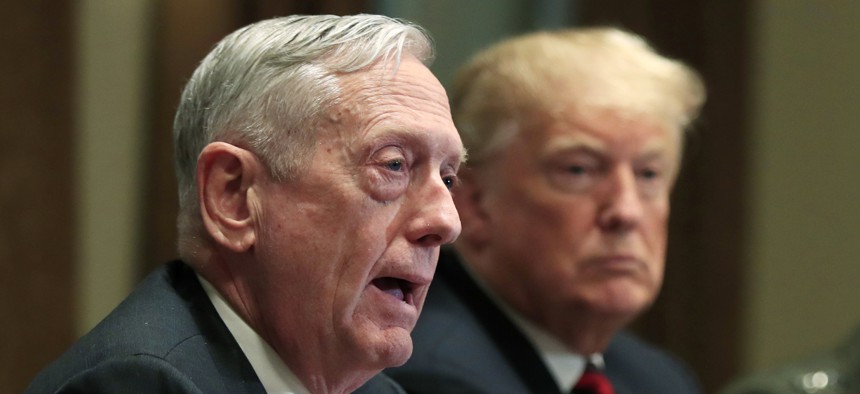
In this Oct. 23, 2018 file photo, Defense Secretary Jim Mattis speaks beside President Donald Trump, during a briefing with senior military leaders in the Cabinet Room at the White House in Washington. AP Photo
The Generals Are Speaking Up. Is That a Good Thing?
Scholars are warning about what others are celebrating as a necessary corrective to a commander in chief gone wrong.
The generals are speaking up.
Over the past three days, Defense Secretary Mark Esper, Joint Chiefs Chairman Gen. Mark Milley, and all of the service chiefs, have issued messages to their troops — on racism, the Constitution, and the role of the military in America — that are starkly at odds with the language of the elected president of the United States.
Their implicit differences with the commander in chief have been joined by explicit condemnation by several prominent retired four-stars, including Trump’s first defense secretary. On Wednesday, Jim Mattis excoriated the president over his handling of the crisis convulsing the nation following the death of George Floyd. Three other prominent retired generals — former Joint Chiefs chairmen Mike Mullen and Martin Dempsey, and retired Marine general John Allen — issued their own public missives condemning the militarized response to the protests and unrest.
Many of Trump’s critics — including at least one GOP lawmaker, Sen. Lisa Murkowski, R-Alaska — have celebrated this upswell of military voices on Trump’s actions. Mattis’s words, she told reporters, were “true and honest and necessary and overdue.”
“When I saw Gen. Mattis's comments yesterday, I felt like perhaps we’re getting to the point where we can be more honest with the concerns we might hold internally and have the courage of our convictions and speak up,” Murkowski said.
But some scholars of the appropriate relationship between civilian and military leadership in U.S. governance and society — known colloquially as “civ-mil relations” — said the weight being placed on the judgment of former uniformed military leaders is as dangerous as the use of uniformed officers to police civil unrest and lawful protest on American soil.
“The generals won't save us, and — if they do — we're already lost, and even more lost than we realize,” tweeted Jim Golby, a combat veteran, former West Point professor, and civ-mil relations scholar.
That’s because civilian control of the military is considered a bedrock principle of the U.S. form of government, explained Mara Karlin, a former Pentagon official who now directs strategic studies at the Johns Hopkins School of Advanced International Studies. Karlin said that system “is predicated on the notion that military leaders give advice but ultimately, civilians will be looking across a wide range of policy and political issues to make decisions on the use of force.” U.S. conviction in that system grows in part out of the nation’s founding: One of the key grievances by the authors of the Declaration of Independence was that King George III “has affected to render the Military independent of and superior to the Civil power.”
Given that fundamental principle, the choice of so many former senior officers to speak publicly on the decisions of the civilian commander in chief is remarkable.
“If this isn’t a civil-military relations crisis, I don’t know what is,” Karlin said. “I think it’s really important that folks appreciate the magnitude and the character of what’s happening right now and recognize that we’ll be living with the baggage for a while now.”
Cv-mil relations can get complicated in the real world, where public perceptions of the military can shape the balance as much as the conduct of the military and its leaders. The military is one of the most widely supported — if commonly misunderstood — institutions in U.S. government. That can give the opinions of current and retired military officers outsized weight in public opinion, allowing them to drive policy in a way that scholars say the founders did not intend.
That’s what appears to be happening now, say Karlin, Golby, and others. For some, Trump’s controversial use of the military to crack down on Americans protesting Floyd’s death is a more pressing concern than the apparent weight given to the words of former flag and general officers.
“I think right now we need to juggle multiple contradictory ideas at once,” Karlin said. “It is far from ideal that retired military leaders are seen as more credible voices, and yet right now, given that that’s the case and that we are facing such extraordinary circumstances, unfortunately it’s incumbent on them to signal to the force that what’s happening right now is neither healthy nor good.”
The next administration — whether in one year or four — will need to “reset” to a more healthy balance, Karlin said.
There is precedent for this kind of speaking out. Scholars of the issue point to 2006, when a handful of former military officers called for then-Defense Secretary Don Rumsfeld’s removal over his handling of the Iraq War. But the impact of their words is difficult to judge, even in hindsight, and the relative obscurity of the issue compared to military policing of nation-wide protests cripples the analogy.
The 2006 “revolt” also involved far fewer officers, Karlin noted, pointing to the public statements issued this week by all of the current service chiefs. Although those statements don’t explicitly criticize or even address Trump or his policies, it is notable how dramatically they differ from the tone set by their commander in chief. The memos acknowledge racism in society and in the military; Trump has spoken little about the underlying conditions that have impelled the unrest. And while the president said on Monday that he has “dispatched thousands and thousands of heavily armed” troops and law enforcement officers, Esper and Milley — who have been widely criticized for joining Trump in a park violently cleared of peaceable protesters — have now both declared philosophical limits on their willingness to deploy troops to confront civil unrest.
Mattis, Mullen, Dempsey, and Allen were all prompted to speak up by Trump’s use of military force, both contemplated and actual, to police demonstrations in American cities. In particular, each pointed to the use of National Guardsmen to help forcibly clear protesters from Lafayette Square, near the White House, so that Trump could walk to a nearby church for a photo op. They also raised concerns about Trump’s threat to use active duty troops to police the protests.
“At home, we should use our military only when requested to do so, on very rare occasions, by state governors. Militarizing our response, as we witnessed in Washington, D.C., sets up a conflict—a false conflict—between the military and civilian society," Mattis wrote in a statement posted to Defense One.
Wrote Mullen: “The United States has a long and, to be fair, sometimes troubled history of using the armed forces to enforce domestic laws. The issue for us today is not whether this authority exists, but whether it will be wisely administered.”
Dempsey added his voice to the mix on Thursday, telling NPR, "The idea that the military would be called into suppress what for the most part were peaceful protests" is "very dangerous."
Trump, along with multiple state governors, have already called up the National Guard to assist in response efforts. The National Guard is a modern-day state militia, and its use in domestic law enforcement is constitutional. But the president can’t use active duty troops for that purpose unless he invokes the 1807 Insurrection Act. Hundreds of active-duty troops are staged on the outskirts of Washington, D.C., in anticipation of that decision.
For civilians in D.C. experiencing the federal response to the protests on the ground, the distinction may not matter.
“As much as natsec wonks may try to distinguish between who is deployed when and where, for the average American, it’s an issue of a six-one, half-dozen another — they all appear the same,” Karlin said.




